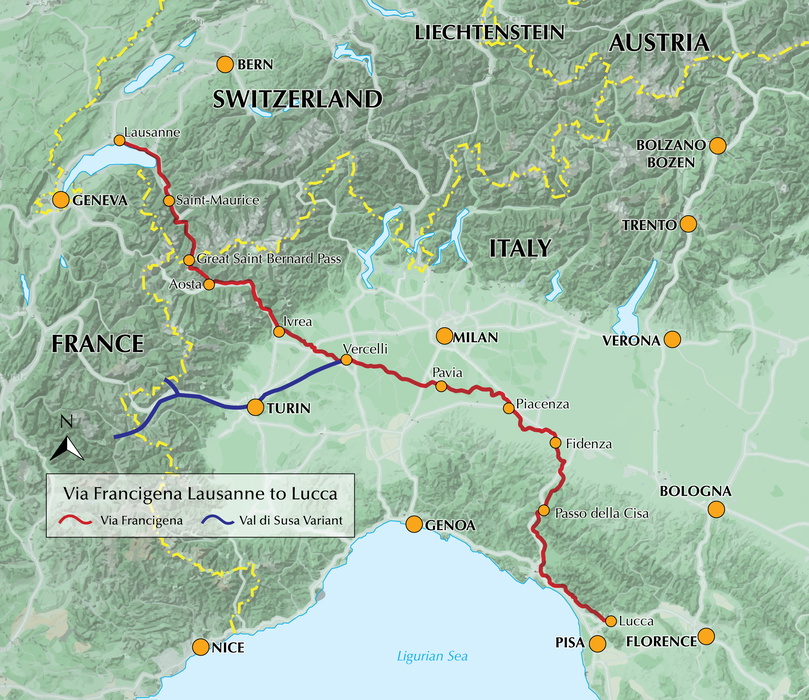
Walking the Via Francigena Pilgrim Route - Part 2
Lausanne and the Great St Bernard Pass to Lucca
Walking the Via Francigena Pilgrim Route - Part 2
Lausanne and the Great St Bernard Pass to Lucca
Guidebook to the Via Francigena pilgrim route from Lausanne to Lucca. Starting at Lake Geneva (Lac Léman), this 725km section crosses the Alps at the historic Great Saint Bernard Pass, descends the Po Valley, then climbs to cross the Cisa Pass into Tuscany. Described in 32 stages, with information on facilities and pilgrim hostels.A guidebook to walking the 3200km Via Francigena pilgrimage route from Canterbury to Rome. Part of a four-volume set, this volume covers the middle 726km, from Lausanne, Switzerland, to Lucca, Italy. Suitable for most abilities – although the crossing of the Jura mountains calls for moderate fitness – this section can be walked in around a month, or there is the option to cycle some of the way.
The route is presented in 32 stages, of between 13 and 34km (8–21 miles).
- GPX files available to download
- 1:100,000 mapping plus larger-scale town maps for key locations
- Handy route summary tables and pilgrim lodging details help you plan your itinerary
- Comprehensive information about refreshments and facilities along the route
- Advice on planning and preparation
Printed book
A guidebook with detailed route descriptions, stage breakdowns, accommodation listings, profiles and maps - everything you need on the trail.
eBook
The complete digital edition of the guidebook, with full route descriptions, accommodation listings, profiles and maps, ready to use on any device.
Route summary table
Map key
Overview profile Lausanne to Lucca
Foreword
Introduction: The Via Francigena from Lausanne to Lucca
A brief history of the Via Francigena
The modern Via Francigena from Canterbury to Rome
Planning your walk
Where to begin and how to get there
When to walk
Cycling all or part of the route
Where to stay
What and where to eat
Should I make reservations ahead?
How much money should I budget?
How do I secure my credential?
Tips for making the most of your walk
Topography of the Via Francigena from Lausanne to Lucca
Understanding local cultures
Training for your walk
What and how to pack
Baggage transport and storage
Telephones
Health and well-being
How to use this guide
Route descriptions
GPX tracks and accommodation downloads
Section 1: The Vaud and Valais
Stage 1 Lausanne to Vevey
Stage 2 Vevey to Aigle
Stage 3 Aigle to Saint-Maurice
Stage 4 Saint-Maurice to Martigny
Stage 5 Martigny to Orsières
Stage 6 Orsières to Bourg-Saint-Pierre
Stage 7 Bourg-Saint-Pierre to Col du Grand-Saint-Bernard
Section 2: Aosta Valley
Stage 8 Col du Grand-Saint-Bernard to Aosta
Stage 9 Aosta to Châtillon
Stage 10 Châtillon to Verrès
Stage 11 Verrès to Pont-Saint-Martin
Section 3: Piemonte
Stage 12 Pont-Saint-Martin to Ivrea
Stage 13 Ivrea to Viverone
Stage 14 Viverone to Santhià
Stage 15 Santhià to Vercelli
Variant Val di Susa to Vercelli
Section 4: Lombardia
Stage 16 Vercelli to Robbio
Stage 17 Robbio to Mortara
Stage 18 Mortara to Garlasco
Stage 19 Garlasco to Pavia
Stage 20 Pavia to Santa Cristina e Bissone
Stage 21 Santa Cristina e Bissone to Orio Litta
Stage 22 Orio Litta to Piacenza
Section 5: Emilia-Romagna
Stage 23 Piacenza to Fiorenzuola d’Arda
Stage 24 Fiorenzuola d’Arda to Fidenza
Stage 25 Fidenza to Fornovo di Taro
Stage 26 Fornovo di Taro to Berceto
Stage 27 Berceto to Pontremoli
Section 6: Liguria and Tuscany
Stage 28 Pontremoli to Aulla
Stage 29 Aulla to Sarzana
Stage 30 Sarzana to Massa
Stage 31 Massa to Camaiore
Stage 32 Camaiore to Lucca
Appendix A Stage planning table
Appendix B Useful contacts
Appendix C Bibliography
Appendix D Sigeric’s journey: then and now
A Via Francigena guide in three parts
Map of the Via Francigena Canterbury to Rome
Profile of the Via Francigena Canterbury to Rome
Seasons
Suitable for walking in spring, summer and autumn. The Great Saint Bernard Pass is fully open to hikers from June to September.
Centres
Lausanne, Martigny, Great Saint Bernard Pass, Aosta, Ivrea, Vercelli, Pavia, Piacenza, Pontremoli, Pietrasanta, Lucca.
Difficulty
Each stage is graded for difficulty (1-4). A few mountainous stages include steep and slippery slopes. No special gear is required to walk the Via Francigena in season, but off-season crossings of the Great Saint Bernard Pass require winter mountain gear and careful attention to changing mountain conditions.
Must See
Dazzling Lake Geneva, the 1500-year-old Abbey of Saint-Maurice, the spectacular 2469m Great Saint Bernard Pass across the Alps, the emerald peaks of Italy's Aosta Valley, well-preserved medieval cities of Vercelli, Pavia and Piacenza, spectacular views from the Monte Valoria at the Cisa Pass, resorts of the Lunigiana coastline and the charming walled city of Lucca.
Free Royal Mail 48 postage on UK orders. European postage is £3.50 per item. Worldwide postage is £5.50 per item. If you're not happy with your purchase for any reason, we'll give you a full refund.
Learn morePopular related guides


























